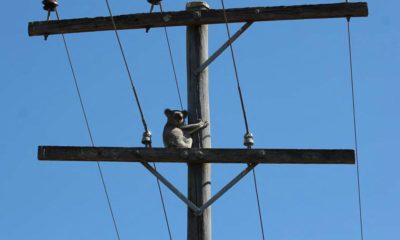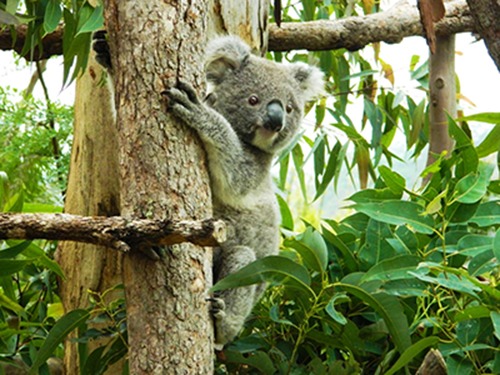Australia is experiencing catastrophic politically driven environmental crises. Extreme right wing governments, dominated by coal devotees, climate change sceptics, focused on endless growth, are destroying ecosystems, forests, river systems and significant levels of biodiversity.
The koala is probably the most visible, globally recognised symbol of this ancient land. An arboreal herbivorous marsupial, it’s the only extant representative of the family Phascolarctidae.
According to Professor Hugh Possingham, koalas are one of five Australian umbrella species. Their habitats, coastal forest ecosystems play significant roles critically important sources of biodiversity, protection from drought, and climate change impacts.
Largely sedentary, koalas sleep up to 20 hours a day. The leaves of a variety of eucalypt species provide their moisture and nutrient needs. Koalas are also faithful to their home ranges, translocations have proved disastrous.
In 1930, President Herbert Hoover was contacted by the Wildlife Preservation Society of Australia and asked to ban the import of koala skins into the US, thus saving the species from extinction.
In 2019, with no guardian angel US President, koalas are once again facing extinction – this time as a direct result of government driven policies of extinction. Massive increases in immigration, requiring major housing developments, urbanisation, infrastructure, together with logging and mining, are wiping out coastal forest ecosystems and the koala.
The Australian Bureau of Statistics (ABS) estimates 526,300 migrants arrived in 2018 alone, a decrease for the first time since 2014. There are more than 400,000 international students in Australian universities.
A State of the Environment Report 2016 spelled out the impacts.
“The concentration of Australia’s population near the coast, mostly in urban areas, creates substantial pressure on coastal ecosystems and environments in the east, south-east and south-west of the country.
The greatest impacts of population growth and demographic change on the environment are in our capital cities and along the coast of Australia, particularly in Queensland.”
New South Wales (NSW) and south-east Queensland are the heartlands of koalas. Two states with coastlines featuring magnificent beaches and a quality of life which entices both city dwellers and immigrants.
State and Federal governments are addicted to growth – at any cost.
To accommodate this ongoing invasion, legislation which provided minimal protection for wildlife and the environment has been repealed in states and at the Commonwealth level. The results have devastating .
In late 2015, a Uniquest report entitled ‘South East Queensland Koala Population Study‘ showed clear statistical evidence of dramatic declines in koala populations in South East Queensland (SEQ). The report showed a decline in densities of around 80% in the Koala Coast area and 54% in Pine Rivers between 1996 and 2014, despite existing protection measures. In fact, rather than a slowing of the rate of decline, there was some evidence to suggest the rate of decline had actually accelerated.
In 2016, a South East Queensland Koala Population Modelling Study Review which covered nearly 10,000 square kilometres showed a catastrophic population crash in the past 20 years .
In March 2017, an interim report from the Koala Expert Panel, established by the Queensland government outlined a long list of failures in government policy, planning and mapping, which continued to put the vulnerable population at risk. It said laws introduced to protect koalas since 2008 have “had very little impact in slowing the rate of habitat loss” and existing laws favored urban development and were “not constructed to halt … impacts on koala populations”.
NSW koalas fared no better.
The right wing NSW Coalition government in 2017 repealed a raft of legislation protecting wildlife and native vegetation. An analysis of the land clearing controls by WWF Australia demonstrated:
“Over 2.2 million hectares of woody vegetation which has been identified as either being known or likely koala habitat could potentially be cleared under the equity code of the new land management framework. This equates to about 13% of the mapped woody vegetation across the State.”
In scrapping the Native Vegetation Act in August, 2017 the government said its decision took the “shackles off farmers” needing to clear vegetation on their own land for the sake of agricultural productivity.
The overhaul saw the annual rate of land clearing in the state soar by 800 per cent over three years.
The Nature Conservation Council claims about 3,000 hectares of native koala habitat was destroyed in the 12 months after the VNA was abolished.
With NSW forests now targeted for bio-energy together with major increases in logging of high koala use areas, the last refuge of the species, their fate is grim. Many forests are suffering from die back as a result of disease caused by disturbance, climate change impacts and weed invasions.
Commonwealth legislation plays a significant role in approval processes for major developments impacting koalas and their habitat. Under the right wing Coalition government, any legal protection has been so weakened as to be completely ineffective.
An interim report by a Commonwealth Senate Committee into Faunal Extinction was published in April. Chair Green Senator Janet Rice’s summary of federal environmental protections is damning.
“The most important issue to arise from the Inquiry thus far is how totally inadequate our current Federal legislation is in terms of protecting the environment. We’re dealing with the drivers of extinction. The Environmental Protection & Biodiversity Act (EPBC Act) is totally inadequate to deal with the situation — the problem is there’s no framework for protection.
So many developments are not referred to the federal government for approval. There are no actions to minimise impacts, a lack of monitoring and compliance.
We have a situation where Federal legislation leaves it up to the states to implement approvals and no mechanisms for follow up.”
Virtually every government sponsored research/report/inquiry since 1998 have recommended legal protection of habitat as the primary mitigation measure. No government has demonstrated any willingness to provide habitat protection.
There are no current population estimates.
The IUCN Red List has designated the koala as one of ten global species most vulnerable to climate change impacts. There are no policies on climate change impacts on koalas, nor have any refugia been identified or discussed by any government.
Professor William Foley described the impacts to koalas. “Elevated atmospheric CO2 reduces the amount of protein available from Eucalyptus leaves may lead to inability to reproduce. “
IUCN states that “Koalas have a very limited capacity to adapt to rapid, human-induced climate change, making them very vulnerable to its negative impacts.”
As a result of the stress levels koalas experience when their home ranges are clear-felled, experts believe koala chlamydia infections — a sexually transmitted disease with symptoms ranging from infertility and blindness to excruciating urinary tract infections and kidney failure — is now at epidemic levels.

Once koalas lose their home ranges, they’re vulnerable to dog attacks, vehicle strikes, starvation and dehydration with high mortality rates. Wildlife hospitals are overflowing with sick and injured koalas, the majority do not survive.
At the recent Federal election, an extreme right wing government was returned to office with promises to build more coal fired power stations and to reject any evidence of climate change.
Koalas are facing deliberately orchestrated extinction. A global tragedy driven by vested interests and irresponsible governments.
The MAHB Blog is a venture of the Millennium Alliance for Humanity and the Biosphere. Questions should be directed to joan@mahbonline.org
The views and opinions expressed through the MAHB Website are those of the contributing authors and do not necessarily reflect an official position of the MAHB. The MAHB aims to share a range of perspectives and welcomes the discussions that they prompt.
